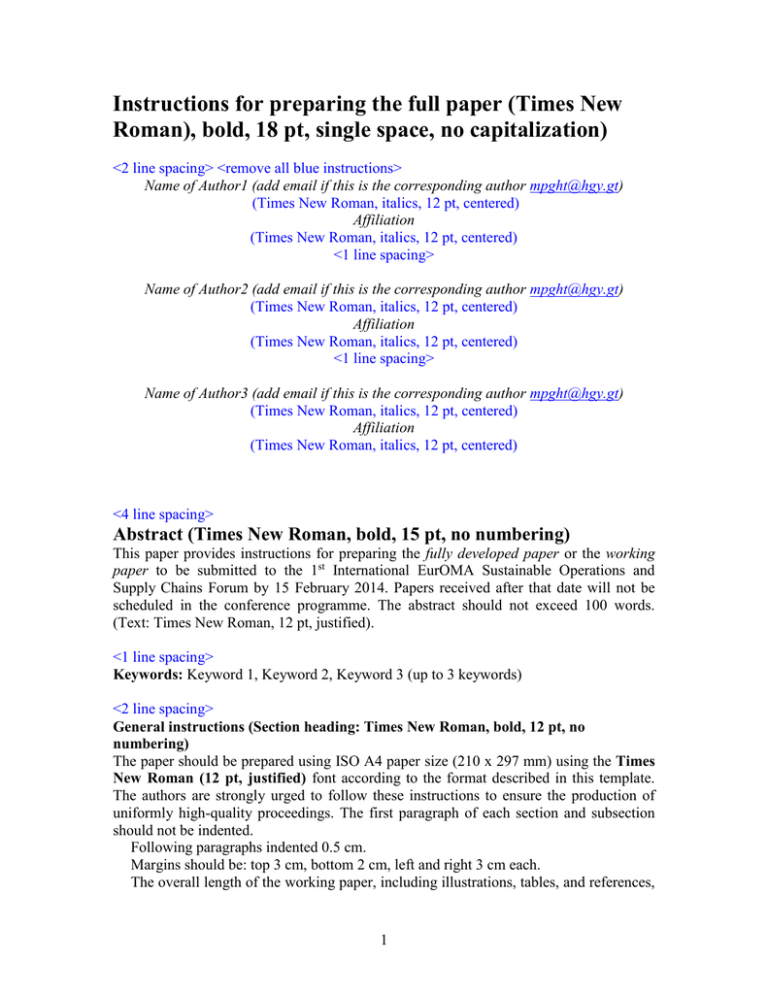Instructions for preparing the full paper (Times New Roman), bold
advertisement

Instructions for preparing the full paper (Times New Roman), bold, 18 pt, single space, no capitalization) <2 line spacing> <remove all blue instructions> Name of Author1 (add email if this is the corresponding author mpght@hgy.gt) (Times New Roman, italics, 12 pt, centered) Affiliation (Times New Roman, italics, 12 pt, centered) <1 line spacing> Name of Author2 (add email if this is the corresponding author mpght@hgy.gt) (Times New Roman, italics, 12 pt, centered) Affiliation (Times New Roman, italics, 12 pt, centered) <1 line spacing> Name of Author3 (add email if this is the corresponding author mpght@hgy.gt) (Times New Roman, italics, 12 pt, centered) Affiliation (Times New Roman, italics, 12 pt, centered) <4 line spacing> Abstract (Times New Roman, bold, 15 pt, no numbering) This paper provides instructions for preparing the fully developed paper or the working paper to be submitted to the 1st International EurOMA Sustainable Operations and Supply Chains Forum by 15 February 2014. Papers received after that date will not be scheduled in the conference programme. The abstract should not exceed 100 words. (Text: Times New Roman, 12 pt, justified). <1 line spacing> Keywords: Keyword 1, Keyword 2, Keyword 3 (up to 3 keywords) <2 line spacing> General instructions (Section heading: Times New Roman, bold, 12 pt, no numbering) The paper should be prepared using ISO A4 paper size (210 x 297 mm) using the Times New Roman (12 pt, justified) font according to the format described in this template. The authors are strongly urged to follow these instructions to ensure the production of uniformly high-quality proceedings. The first paragraph of each section and subsection should not be indented. Following paragraphs indented 0.5 cm. Margins should be: top 3 cm, bottom 2 cm, left and right 3 cm each. The overall length of the working paper, including illustrations, tables, and references, 1 is limited to 10 pages in case of a working paper and 20 pages in case of a fully developed paper. <1 line spacing before subheading and section heading, no space after heading and subheading> Other details (subheading: Times New Roman, italics, 12 pt, no numbering) Pages should be numbered in the page footer (center), including the first page, as is done here. Papers should be organized in the following sequence: Title of the paper, name(s) of the author(s), affiliation(s) Abstract Keywords Main subject text Acknowledgments (when applicable) References Bulleted or numbered lists should have hanging indent by 0.5 cm. Avoid using more than two levels in the lists. Following paragraphs indented 0.5 cm. Footnotes should be avoided. The corresponding text should be incorporated in the main text. Equations should be typed flush with the left-hand margin and numbered consecutively with numbers in brackets on the far right. Leave single spacing above and below equations, like shown in equation (1). N ∑xi = δ (1) I=1 Figures and tables must be included in the main text and must be individually numbered and captioned. Illustrations should be sharp and clear. Text in tables should be Times New Roman 11pt. Place figures and tables centered. Captions should be placed below figures and above tables. They are typed in Times New Roman 11, in italics, and centered. Leave one line before and after tables and figures (see examples below). <1 line spacing before table> Table 1 – Caption (Times New Roman, Italic, 11 pt, centered) <1 line spacing after table> <1 line spacing before figure> Figure 1 – Caption (Times New Roman, Italic, 11 pt, centered) <1 line spacing after figure> This is an example of main text, and is the last line of the section. 2 2 <1 line spacing> Language All papers must be in good English. Please proof read carefully your own paper. Mistakes cannot be changed later. Conclusion The above has shown the main instructions for writing the text. All is missing now are instructions regarding references. References to other publications should be in Harvard style. They should contain full bibliographical details. Journal titles should not be abbreviated. References should be presented as follows. Within the text: Author’s last name followed by a comma and the year of publication, all in round brackets; e.g., (Fox, 1994). When the number of authors is three or more, references in the text should be (Fox et al., 1995). At the end of the paper, list all references in alphabetical order. In the reference list all authors should be included. References A full reference list should be included. Font: Times New Roman, 10 pt, left aligned, hanging indent 0,5 cm). For books: Surname, Initials (Year of Publication), Title, Publisher, Place of Publication. Casson, M. (1979), Alternatives to the Multinational Enterprise, Macmillan, London. For chapters in edited books: Surname, Initials (Year), “Title”, in Editor’s Name, Initials (Ed.), Title, Publisher, Place, Pages. Bessley, M. and Wilson, P. (1984), “Public policy and small firms in Britain,” in Levicki, C. (Ed.), Small Business Theory and Policy, Croom Helm, London, pp. 111-126. For articles: Surname, Initials (Year), “Title”, Journal Name, Volume, Number, Pages. Fox, S. (1994), “Empowerment as a catalyst for change: and example from the food industry”, Supply Chain Management, Vol. 2, No. 3, pp. 29-33. Electronic sources should include the URL of the web site at which they may be found along with the date of latest access. 3






